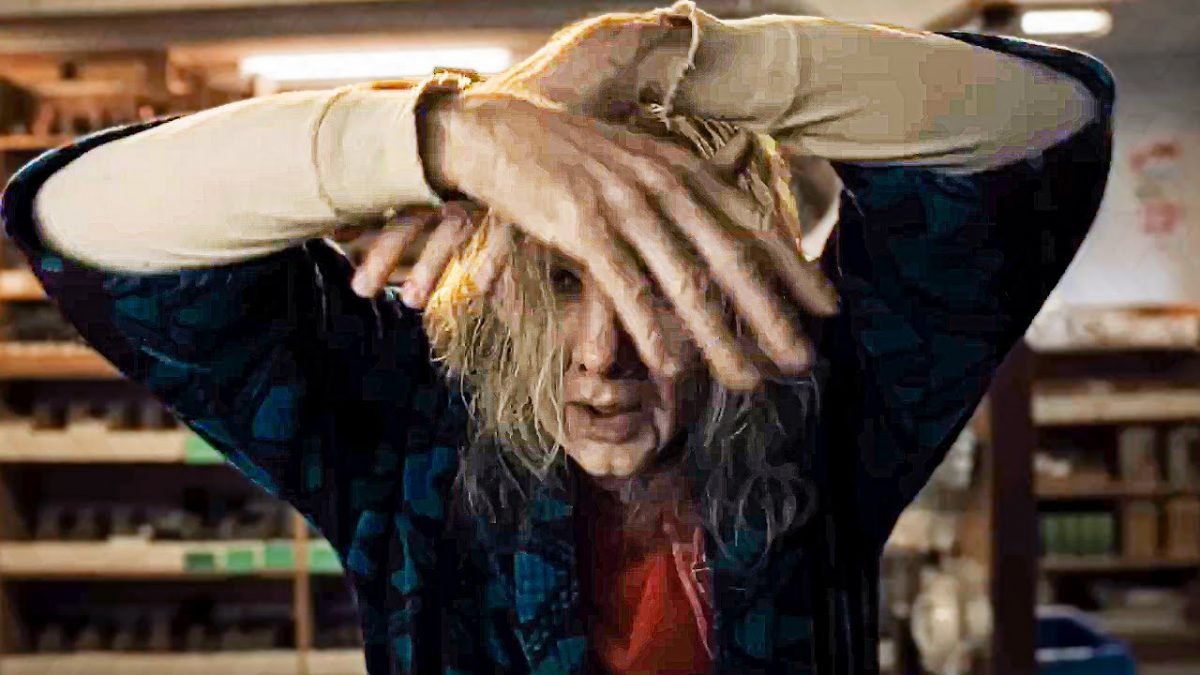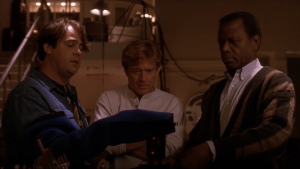
It might seem an unusual place to start from, but for director and actor alike, Longlegs is a film about mothers. Their mothers. The very idea of it is a curious admission since Longlegs is an infinitely disturbing hybrid of the religious horror movie and the serial killer thriller. Yet Oz Perkins still makes the point while discussing how the movie’s script brought him and Nicolas Cage together—and with the latter playing one of the most disturbing characters to date in Cage’s oeuvre.
Set in the 1990s, Longlegs is a period piece which revisits the era when the serial killer thriller was coming into prominence thanks to movies like The Silence of the Lambs, and just after America’s obsession with the “Satanic Panic” from recent decades had begun to break. It is in this context we meet Lee Parker (Maika Monroe), a young FBI agent who was raised by a deeply religious and sequestered mother (Alicia Witt) before pursuing a life in law enforcement. But that evangelical background will come back to the fore of Lee’s mind when she is assigned a cold case by her supervisor (Blair Underwood). This fateful action also puts her on a collision course with a serial killer who calls himself Mr. Longlegs (Cage). He’s a creature so hideous, with his crumbling makeup and stringy hair, that even on a bright sunny day you’d be compelled to flee well before he begins talking about serving “the man downstairs.”
“Early on I said to him, ‘you know, this movie is about my mom, Nic,’” Perkins recalls during a sitdown with Den of Geek last month. “And he said, ‘Well, actually this movie’s about my mom, Oz.’”
Cage has spoken occasionally before about his mother Joy Vogelsang’s struggles with mental illness during his youth. As a child, Cage watched his mother be institutionalized several times, undergoing multiple rounds of shock therapy among other treatments (Vogelsang passed away in 2021).
“He connected early on to wanting to sort of exorcise some of his mom’s mental difficulties that he had experienced as a kid,” Perkins explains. “I know for a fact she had some significant mental health issues that really scared him. I think that he saw in this movie an opportunity to voice some of that and give the mic to a little bit of it.”
It might seem unlikely given the setup of the film. While the relationship is certainly complicated between Monroe and Witt’s characters, the proverbial daddy Longlegs is something altogether more nefarious. The first scene of the film, in fact, is of a little girl in a pastoral field finding a nigh unrecognizable Cage manifesting seemingly out of thin air behind her. He has a grotesquely manic grin on his face as he tries to befriend the child by explaining he is wearing “my longlegs today!”
He’s repellent, and yet there is something vaguely pitiful about this wretched creature. Finding sympathy in monsters, however, has always been one of the hallmarks of Perkins’ work in horror films like The Blackcoat’s Daughter and 2020’s more fairytale-like Gretel & Hansel.
“I think it’s someone who was a person and is a person, and whose life was sort of hijacked by the Devil,” Perkins says of Longlegs. “You go into the service of that and it sucks, and you do your best to sort of be evil through it, with it, as a result of it, but in the end you’re also a person who gets tired.” In some ways, it resembles the twisted journey of The Blackcoat’s central protagonist, a little girl played by Kieran Shipka (who also appears in Longlegs) that is literally possessed by the Devil… and yet comes to rather enjoy the experience.
“We often fuck things up, right?” Perkins says while considering the level of complicity of his most nefarious characters. “We don’t try to necessarily hurt people [but we do]. We make bad decisions, we regret the choices we make. We drive badly as a result of other people driving badly. Sometimes our best selves are not in fashion. I think when dealing with the characters I’ve written, they’re typically lost people who just get picked up. They’re hitchhiking on the road of life and they get picked up by the wrong car, and then life just sort of takes its course. And when you’re dealing with something as appealing as the Devil is supposed to be—that’s his thing, right? He’s appealing.”
It’s a twisted spin on the religious horror movie, albeit the actual Satanic Panic media frenzy that Longlegs plays with didn’t personally interest Perkins back in the day. His only vague awareness of it while growing up in the 1980s in Los Angeles was news reports on Richard Ramirez, the so-called “Night Stalker” serial killer. He also seems amused at the still persistent fear in parts of American culture of supposedly real devil worshippers.
“If there’s anything interesting about devil worship in America, it’s that it’s sort of fundamentally misunderstood,” Perkins says. “It’s like people who believe in QAnon think that devil worship is eating babies, right? And devil worship is definitely not eating babies. It’s just being the upside-down version of everything else and kind of moving away from the puritanical resistance that religious people inflict.”
A movie like Longlegs, then, is less a literal movie about devils, and more an insidious exploration of how people can be compelled (or allow themselves to be compelled) to do truly evil things. Cage, for instance, talked a lot with Perkins about the performances of Lon Chaney Sr. while developing the heightened countenance of Longlegs, while the people his presence affects are filmed by Perkins in often detached wide-angles. The filmmaker likens his compositions and filmic language to crime scene photographs.
“Crime scene photographs are the epitome of matter of fact,” Perkins explains. “It’s a document, it’s not an artwork; but that makes it an artwork. Like an Ed Ruscha photograph of an old apartment building is just a picture of an old apartment building, but because he chose to make it and because he chose to make it in this non-critical way, it has a new life to it. So we created all these crime scene photograph [images] in a very matter of fact way… Everything is sort of from here. That to me expresses, ‘Oh, this is going to happen no matter what.’ There’s an inevitability to bad things happening when you maintain a sort of distance of observation.”
Still, one of the unnerving things about Longlegs is its ability to hone in on unnerving images that are sometimes almost subliminally edited into the picture, and often in extreme close-up. There are even images that might stem from Perkins’ own subconscious. For instance, it is hard to miss a vision Lee Harker has of blood spinning down a drain and not think of the Longlegs director’s father, actor Anthony Perkins.
“We went out to shoot the snakes at a snake preserve outside of Vancouver,” Perkins says of developing some of the flashing subliminal images meant to signify evil in the movie. “And we just [filmed with the lens looking] into a sink when they took the snakes out. And [we go], ‘Oh, it looks like Psycho!’ It’s just there and you might as well get it.” It’s an image that certainly means something to Perkins’ own upbringing, but the director says its inclusion in a movie like Longlegs stems from his style of direction, which is entirely about catching natural, unexpected moments of inspiration.
“My job as director, once it’s a script and then once it’s been developed by the departments in pre-production, my job as director on the set is to watch and to see things when they happen. And if I see something, I say something.”
Longlegs has a lot to say about evil, mothers, and more when it opens on Friday, July 12.
The post Longlegs: Oz Perkins and Nicolas Cage Find Sympathy for the Devil Worshipper appeared first on Den of Geek.





